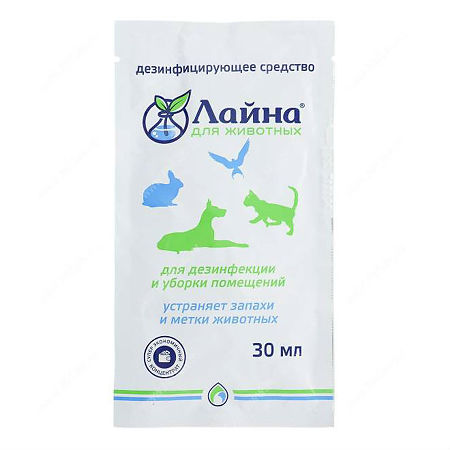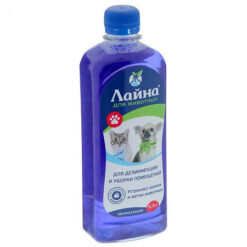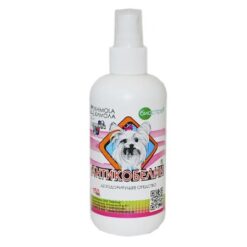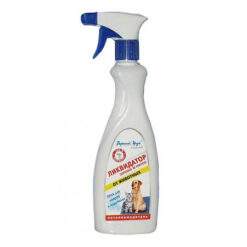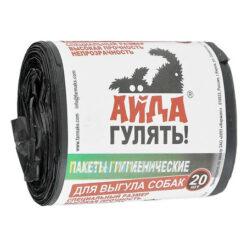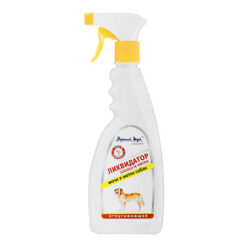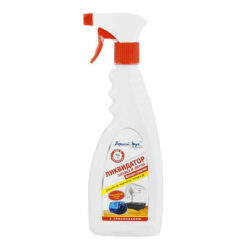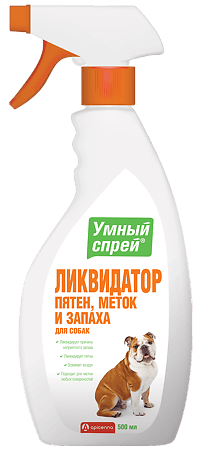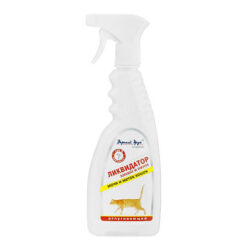No products in the cart.
🐾 Laina Sanitizer for disinfecting, cleaning and removing unpleasant odors and pet marks SASHE, 0.03 l
€3.00 €2.73
Description
Laina has a broad spectrum of antimicrobial action against infectious agents of bacterial (including tuberculosis), viral (adenoviruses, herpesviruses) and fungal etiology. According to degree of impact on organism Laina is a low-hazard substance (4th class according to GOST 12.1.007-76), after injection in stomach and at application on skin – LD50-6040. Laina has pronounced washing and deodorizing properties, does not discolour fabrics, does not corrode metals, does not destroy plastics, rubber and other materials. Solutions of the product have antistatic properties. The product is not compatible with soaps and anionic surfactants.
Special instructions
Special instructions
Pregnant and lactating women, as well as teenagers under 18 years of age are not allowed to work on disinfecting premises using the drug.
The treatment is carried out in special clothing: a cotton suit (or overalls), a headdress, a rubberized apron, and rubber gloves. When carrying out aerosol treatment to protect the respiratory organs and eyes, use a gas mask (GP-4U, GP-5) or a universal respirator (RPG-67, RU-60M) with a gas cartridge of grade A or B and sealed goggles (PO-2, PO-3). During work, smoking, drinking, and eating are prohibited. If Laina gets on your skin, wash it off with water. In case of contact with eyes, rinse them immediately under running clean water for 5 minutes. If the product gets into the stomach, give the victim to drink 3-4 glasses of water and take adsorbents (for example, 10-20 tablets of activated carbon). Do not induce vomiting. If necessary, consult a doctor.
Recommendations for use
Recommendations for use
Disinfection of livestock, poultry or fur farming premises is carried out in the absence of animals using a wet (irrigation, immersion, wiping) or aerosol method after thorough cleaning and washing of the premises. Working solutions of the product are prepared immediately before use, taking into account the required volume and required concentration by adding the appropriate amount of the product to drinking water.
Disinfection using the wet method is carried out by fine-droplet irrigation of the surfaces of premises and elements of technological equipment using disinfection units DUK-1, DUK-1M, AVD-1, UDP-M, LSD-3M, LSD-EP.
For preventive and forced (current and final) disinfection of livestock, household and auxiliary premises, equipment, isolation wards, slaughterhouses, for infections whose pathogens belong to the group of low resistance to disinfectants (group 1), the quality of disinfection in which is controlled by the release of E. coli, use a 1% solution at a consumption rate of 0.3 l/m2 and an exposure time of 1 hour.
For forced (current and final) disinfection for infections whose pathogens belong to the group resistant to the main disinfectants (group 2), the quality of disinfection in which is controlled by the release of staphylococcus, use a 2% solution at a flow rate of 0.3 l/m2 and an exposure time of 3 hours.
In all cases, when processing elements made of porous materials (unpainted wood, cement, rubber), the consumption rate of the product is increased to 0.5 l/m2.
For preventive and forced (current and final) disinfection at points of primary processing of meat, milk and eggs, for infections whose pathogens belong to the group of low-resistant (group 1) and resistant (group 2) to disinfectants, the quality of disinfection is controlled by the isolation of E. coli and staphylococcus, using a 2% solution, once, at a flow rate of 0.3 l/m2 and an exposure of 1 hour.
In case of animal tuberculosis, forced disinfection is carried out with a 3% solution of the product at a consumption rate of 0.3 l/m2 and exposure time of 3 hours.
For trichophytosis in cattle and aspergillosis in birds, a 4% solution is used with a consumption rate of 0.5 l/m2 and exposure time of 3 hours. For adenoviral infection of cattle, a 3% solution is used at a consumption rate of 0.3 l/m2 and an exposure of 4 hours; for infectious rhinotracheitis, a 2% solution is used at a rate of 0.3 l/m2 with an exposure of 1 hour.
Wet disinfection of the surface of hatching eggs is carried out with a 0.1% solution of the product. Clean eggs of normal shape, without cracks, cracks and notches, placed in trays before being placed for incubation, are processed by immersing them in a container with a disinfectant solution for 5 minutes, after which they are dried in air at room temperature. Additional disinfection of eggs during incubation is not required.
Aerosol disinfection of premises is carried out with a 2% solution at a rate of 20 ml/m3 using aerosol generators SAG-1, TsAG or others. Sprayers are suspended at a height of at least 1 m from the floor surface at the rate of 1 sprayer per 800-1000 m3. Before spraying the working solution, the room is sealed (windows, doors, and ventilation hatches are tightly closed). To disinfect egg warehouses and hatcheries, use 0.5% solutions at the rate of 20 ml of working solution per 1 m3 with an exposure of 30 minutes.
Preventive disinfection of premises, equipment, equipment and animal care items in zoos, circuses, nurseries, vivariums, veterinary hospitals and clinics, as well as in places where domestic animals are kept, is carried out using a wet method with a 0.5% solution with an exposure of 0.5 hours. To wash and disinfect laboratory glassware, use a 0.5% solution with an exposure time of 1 hour.
Forced disinfection of surfaces for bacterial infections (except tuberculosis) is carried out with a 0.2% solution of the product with an exposure of 2 hours, for fungal infections and tuberculosis – with a 3% solution with an exposure of 3 hours. For viral infections, disinfection is carried out with a 3% solution of the product with an exposure of 4 hours. Consumption of working solutions is 0.1 l/m2.
Floor carpets and upholstered furniture are treated with a 2% solution at the rate of 0.2 l/m2, then cleaned. Disinfection time 4 hours. When treated twice with an interval of 15 minutes, the disinfection time is 2 hours, the consumption of the working solution during repeated treatment is 0.1 l/m2. Cat litter boxes, toys, dishes and other pet care items are completely immersed in a 2% solution for 2 hours, then rinsed with clean water. Fabric products are soaked in a 2% solution of the product at the rate of 5 liters of solution per 1 kg of products with an exposure of 1 hour, then washed and rinsed with clean water. Workwear is disinfected by soaking in a 1% solution with exposure for 3 hours. The consumption of the working solution is 5 liters per 1 kg of dry workwear.
After the established disinfection exposure, feeders, drinking bowls and other objects accessible to animals, places of direct contact with raw materials, products of animal origin, places of possible accumulation of product residues are washed with water. There is no need to rinse off product residues from other surfaces. At the end of the exposure, premises for keeping animals, including poultry, are thoroughly ventilated and dried. It is allowed to carry out local disinfection using a wet method in individual animal-free stalls, bird cages, in occupied livestock buildings, providing intensive ventilation and the absence of people and animals in close proximity to the objects being treated.
Quality control of disinfection is carried out in accordance with the methodology set out in the current “Rules for disinfection and disinfestation of objects of state veterinary supervision” (2002). Sterile water is used as a neutralizer.
Side Effects
Side Effects
When inhaled in saturating concentrations, the product is classified as a low-hazard substance in terms of volatility. Aqueous solutions of the product do not have a local irritant or sensitizing effect. Safe for animals; no rinsing with water is required after treatment.
Manufacturer
Manufacturer
Hemiline, Russia
Additional information
| Manufacturer | Chemeline, Russia |
|---|---|
| Brand | Chemeline |
Other forms…
Related products
Buy 🐾 Laina Sanitizer for disinfecting, cleaning and removing unpleasant odors and pet marks SASHE, 0.03 l with delivery to USA, UK, Europe and over 120 other countries.

